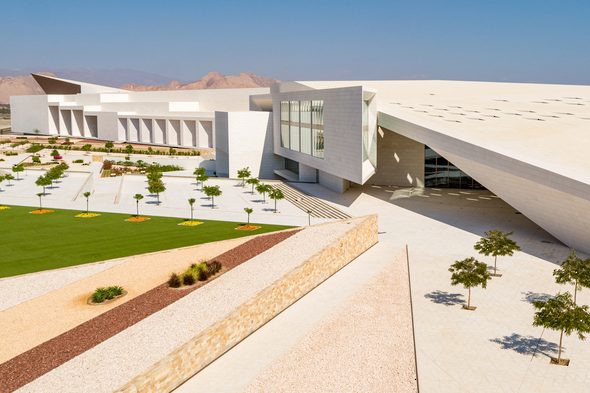
Oman Across Ages Museum – an epitome of past glories, an icon of the renaissance
The Oman Across Ages Museum, inaugurated on Monday March 13 by His Majesty Sultan Haitham bin Tarik, is a celebration of the country’s rich history, culture and economic growth through time – while offering an insight into Oman’s tomorrow.
The Museum is a cultural and educational landmark for all Omanis taking the visitor on a vast, sweeping journey through time.
It traces the story of Oman from the first settlers of prehistory to the present, spanning different ages, dynasties and civilisations.
Special emphasis is given to Oman's renaissance since the 1970s, during which the Sultanate has experienced remarkable economic, technological, political and social progress. This unique journey is displayed with the extensive use of interactive visual and sound presentations and devices.
The Museum seeks to highlight the unique character of the Sultanate of Oman, and introduce its prominent features, its ancient history and the continuing progress of its renaissance at both local and international levels under the wise leadership of His Majesty.
Oman Across Ages Museum is located in the Wilayat of Manah in the heart of the Governorate of A’Dakhiliyah just one hour and 40 minutes (160 km) by car from Muscat and 20 minutes (20km) from Nizwa (for more information click here).
The Museum demonstrates Oman’s transition from its past glories, to the present and into the bright future in a modern style.
The Museum aims to spread awareness and strengthen the relationship of Omani youth with their cultural heritage. It encourages them to interact with their past in a way that inspires them to participate in the building and shaping the future of their homeland.
In 2015, His late Majesty Sultan Qaboos bin Said laid the foundation stone for the Museum in the Wilayat of Manah, Governorate of A’Dakhiliyah.
Today, the project occupies an area of 300,000 square metres and its buildings cover more than 66,000 square metres. Its design is inspired by the Al Hajar mountains – an architectural wonder that represents the Omani environment, with its unique geographical traits.
The Museum portrays Omani architecture in a unique modern style, through its technical details, construction features and building materials.
The Oman Across Ages Museum is an environmentally-friendly structure. On its eastern side it has a low profile, so that when it receives sunlight in the morning the inside is protected from direct sunlight. On its western side, the Museum's windows are set in slanted walls that prevent the impact of direct sunlight and reduce the energy that the Museum needs for lighting.
Its design replicates the building techniques of castles and ancient buildings – its walls cooling the surrounding hot air thanks to the 130,000 square metres of high-quality Omani stone from the governorates of A’Dhahirah and North Al Batinah used to clad the walls of the Museum, both inside and out. Waste material from the stones has been used in the Museum's garden.
The Museum is distinguished by its glass facades rising as high as 25 metres, giving the building a clear silhouette that dominates the horizon.
Four layers of glass are used, 6 centimetres thick and up to 5 metres high. This means the Museum offers astounding views, while harmonising the building with its surrounding environment.
Once a visitor sets foot inside they are taken on a journey through the geography and history of Oman – the oldest items in the Museum date back to prehistoric eras.
The Museum houses two main galleries – The History Gallery and The Renaissance Gallery.
The History Gallery consists of a series of pavilions each dedicated to a particular subject: The Land of Oman, Early Settlers, The Civilisation of Magan, The Kingdom of Magan, Maritime Heritage, Aflaj Irrigation, Embracing Islam, The Al Ya’aruba Dynasty and The Al Busaidi Dynasty. In this way visitors can travel through time and space, right from the country’s geological formation, through the experiences of the early settlers to the modern Renaissance age.
The History Gallery also relates various events to their historical epochs, with two basic features taking prominence, which are Maritime Heritage and Aflaj (a traditional irrigation system). The geological formation of the Land of Oman and the Stone Age are represented in the Early Settlers pavilion, the Bronze Age is seen through the Civilisation of Magan pavilion, while the Iron Age is represented in the Kingdom of Oman pavilion.
Exhibits are introduced via digital media to create multi-dimensional environments that enable the visitor to experience each era in virtual reality.
The History Gallery also explores the eras of the Al Ya’aruba Dynasty and then the Al Busaidi Dynasty. This chronicles the period of the State’s establishment, the period of the Omani Empire, the period of division of government between Muscat and Zanzibar and the period that led to the Renaissance. The emphasis is on aspects of daily life and achievements in various fields of life during the rule of the Imams and Sultans of the Al Busaidi Dynasty.
The Renaissance Gallery consists of pavilions titled Dawn of the Renaissance, Building A Nation, Our Society, Healthy Environment, Peace and Stability, Towards A Sustainable Economy, Infrastructure and Connectivity, Ash Shura, Oman and the World, Inspiration, Creative Expression and Media and Communications.
This Gallery explores the social, economic, industrial and political transformation experienced by Oman, while preserving its authentic identity and cultural traditions.
The Gallery comprises interactive digital exhibits that display the speeches of His Majesty Sultan Haitham bin Tarik and of the late Sultan Qaboos bin Said.
In total the Oman Across Ages Museum houses 310 video exhibits and 1,200 interactive, 2D and 3D screens, map projection technology, as well as 1,300 antique exhibits, 80 replica exhibits, 500 text panels and drawings, 150 display boxes, 61 kilometres of fibre-optic cables and 21 kilometres of audio-video cables.
The Museum includes educational games for children with interactive technologies that provide a unique museum experience.
The Museum also contains a Knowledge Centre, which is an information resource for students, researchers and readers. The Centre represents a key feature of the Museum and comprises a rich source of information that contributes to building knowledge for all, from children to researchers.
The Centre provides equal opportunities for all to benefit from its facilities, equipment and services, promoting and developing cultural and historical knowledge by providing lifelong learning opportunities via interactive educational programmes, training workshops, lectures and seminars.
The first and second floors of the Knowledge Centre house the library of Husn Al Shumookh. The library contains more than 46,000 titles in various areas of science and knowledge. It is equipped with technology that allows researchers to access their desired titles and references, in hard copies or electronic form.
The Library provides services in person to visitors or remotely via a digital reference service operating through the Centre’s website, an instant chat service and an “Ask the Librarian” form. Services are also available via email, smartphone applications and social media. The Library's facilities also include a lecture hall, a multi-purpose hall and facilities for disabled people.
The Museum also has a shop, which offers a wide range of exclusive gifts with attractive designs, many of which are inspired by the history, heritage and culture of the Sultanate of Oman.
Oman Across Ages Museum is located in the Wilayat of Manah in the heart of the Governorate of A’Dakhiliyah just one hour and 40 minutes (160 km) by car from Muscat and 20 minutes (20km) from Nizwa (for more information click here). It will be open to the public from March 18th.
This is an unofficial English translation of the original Arabic text. To view the official Arabic text, click here.









